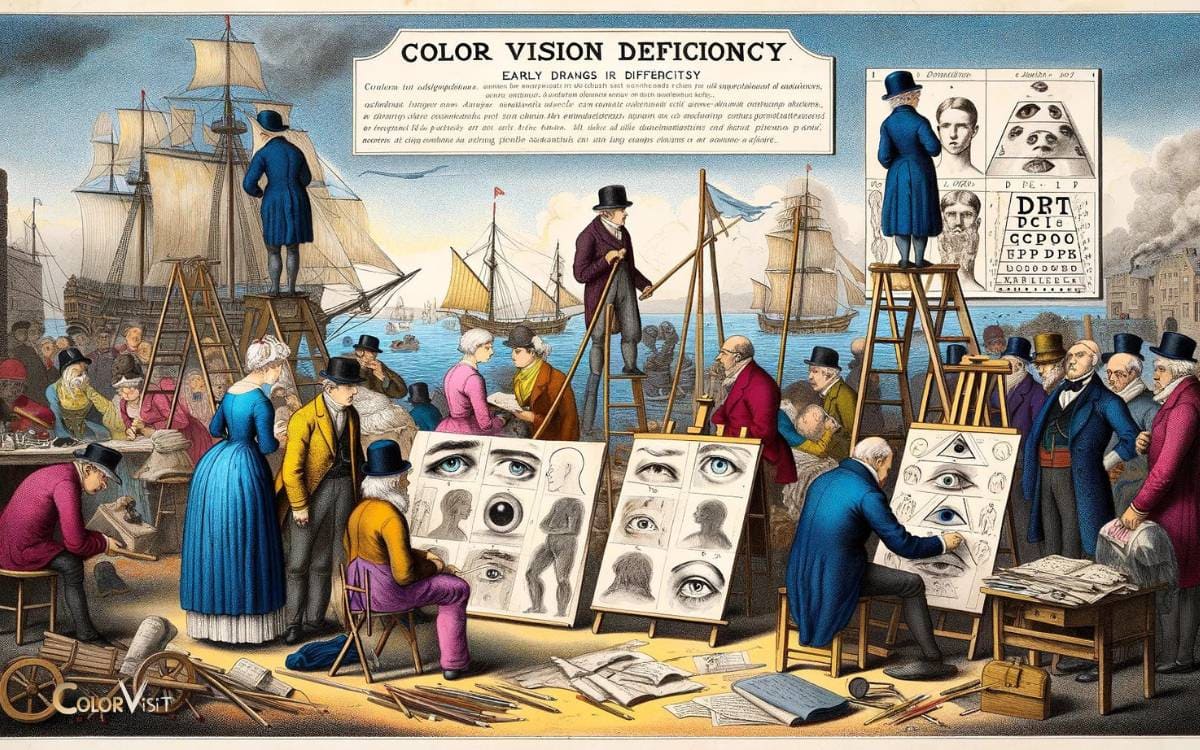History of Red Green Color Blindness: 8% Men – 0.5% Women!
The history of red-green color blindness, affecting about 8% of men and 0.5% of women globally, is a fascinating narrative of scientific innovation and discovery.
From the earliest observations to the development of diagnostic tools and its impact on art and design, the understanding and treatment of this visual impairment has significantly evolved.
Red-green color blindness is a type of color vision deficiency characterized by difficulty distinguishing between red and green hues.
This condition has a rich history, spanning from preliminary observations to breakthrough scientific findings.
Essential milestones in this history include:
The historical journey of understanding red-green color blindness has shaped our current knowledge and future research, providing valuable insights into this widespread visual impairment.
Key Takeaway
Early Observations of Color Vision Deficiency
The first recorded observations of color vision deficiency date back to the late 18th century when the condition was documented in a small number of individuals.
- Early studies on color perception and observations of visual impairment laid the foundation for understanding color vision deficiency.
- In 1794, John Dalton published the first scientific paper on the topic after recognizing his own color blindness. His work marked the beginning of extensive research into the condition.
- Further studies in the 19th and 20th centuries expanded the understanding of color vision deficiency, leading to the development of diagnostic tests and the identification of different types of color blindness.
These early observations paved the way for modern advancements in diagnosing and managing color vision deficiency, contributing to the ongoing innovation in this field.
Scientific Investigations and Discoveries
Scientific investigations and discoveries have significantly advanced the understanding of red-green color blindness, building upon the early observations and studies conducted in the 18th and 19th centuries.
Key findings include:
- Genetic Inheritance: Research has identified specific gene mutations on the X chromosome as responsible for red-green color blindness, shedding light on the hereditary nature of this condition.
- Neural Pathways: Studies have delved into the neural pathways involved in color vision, elucidating how deficiencies in these pathways lead to red-green color blindness.
- Gene Therapy: Recent breakthroughs in gene therapy offer promising avenues for potential treatment and management of red-green color blindness.
- Functional Imaging: Advanced imaging techniques have enabled the visualization of brain activity associated with color perception, providing valuable insights into the mechanisms underlying color blindness.
- Pharmacological Interventions: Ongoing research explores the potential of pharmacological interventions to modulate neural pathways and alleviate the effects of red-green color blindness.
Development of Diagnostic Tools
Development of diagnostic tools for red-green color blindness has been crucial in advancing early detection and accurate assessment of this condition.
- Genetic testing plays a pivotal role in the development of these tools, allowing for the identification of specific genetic mutations associated with red-green color blindness.
- The emergence of advanced genetic testing techniques, such as next-generation sequencing, has significantly enhanced the precision and efficiency of diagnosing this condition.
- Additionally, innovative diagnostic tools, such as color vision tests and specialized computer-based assessments, have been developed to evaluate color perception and distinguish between different types and severity of color vision deficiencies.
- These tools enable healthcare professionals to diagnose red-green color blindness more effectively, leading to improved management strategies and personalized interventions for individuals affected by this condition.
The continuous evolution of diagnostic tools continues to drive progress in the early identification and management of red-green color blindness.
Impact on Art, Design, and Everyday Life
Red-green color blindness profoundly influences artistic expression, design choices, and daily activities for those affected.
This condition impacts individuals in various ways, including:
- Artistic Expression: Color perception plays a pivotal role in art creation, and colorblind individuals may face challenges in accurately perceiving and using colors in their work.
- Design Aesthetics: Designers need to consider the accessibility of their designs for colorblind individuals to ensure inclusivity and effective communication.
- Everyday Challenges: Tasks like selecting ripe fruits, understanding traffic lights, and coordinating clothing can be more challenging for individuals with red-green color blindness.
- Color-Coded Information: Understanding color-coded graphs, maps, and charts becomes difficult, affecting the interpretation of important information.
- Occupational Limitations: Certain professions such as electricians, pilots, and graphic designers may pose challenges due to color-coding and color-dependent tasks.
Current Research and Future Outlook
Research advancements in the field of red-green color blindness are focused on gene therapy, aiming to address the root cause of the condition.
- Scientists are exploring methods to correct the genetic mutations responsible for red-green color blindness, offering the potential for long-term solutions.
- Additionally, there is a growing emphasis on social implications and accessibility initiatives, aiming to enhance the daily lives of individuals with color vision deficiency.
- Future outlooks include the development of more accurate diagnostic tools and personalized treatment approaches, tailored to the specific genetic variations of each individual.
These advancements hold promise for improving the quality of life for those with red-green color blindness.
Conclusion
The history of red-green color blindness has been marked by early observations, scientific investigations, and the development of diagnostic tools.
This condition has had a significant impact on art, design, and everyday life, leading to ongoing research and future prospects for improved understanding and management.
The study of color vision deficiency continues to be a fascinating and evolving area of exploration, offering intriguing insights into the complexities of human perception.






